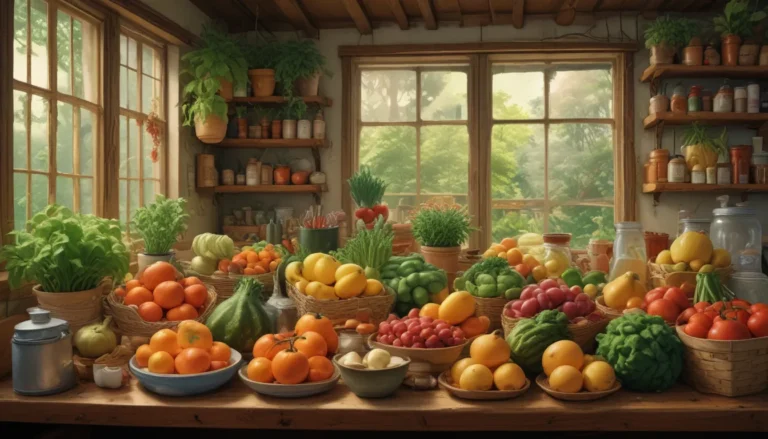How to Successfully Cultivate Peach Trees in Containers

Peach trees, belonging to the species Prunus persica, are beloved by many for their delicious fruit. That first juicy bite of a ripe peach carries us back to fond memories of summer days and carefree picnics. If you are eagerly anticipating that first bite of your very own homegrown peach, then growing a peach tree in a container can be a wonderful solution.
If you are tight on space but still want to enjoy fresh, homegrown fruit, container planting is the way to go. It allows you to place your peach tree in a sunny location, then easily move it indoors during harsh weather or cooler seasons. Plus, most peach tree varieties are self-fertile, meaning you can get fruit even from a single tree.
In this detailed guide, I will walk you through everything you need to know about growing peach trees in containers. From selecting the best cultivars to planting and maintenance tips, you’ll be on your way to cultivating your very own peach tree in no time.
What You’ll Learn
- Best Peach Cultivars for Containers
- Choosing the Right Pot
- Preparing Potting Soil
- Steps and Tips for Planting
- Care and Maintenance
- Dealing with Pests and Diseases
- Repotting for Success
Ready to get started on your peach tree-growing journey? Let’s dive in together!
Best Peach Cultivars for Containers
When selecting a peach tree for container growing, it’s essential to choose a dwarf cultivar that is suitable for confined spaces. Look for varieties specifically bred for container cultivation, often labeled as “patio peaches.” Some popular dwarf peach cultivars to consider include ‘Bonanza,’ ‘Bonfire,’ ‘Empress,’ and ‘Golden Glory.’
Before you decide on a cultivar, ensure that it is suitable for your USDA Hardiness Zone and can fulfill its chilling hour requirements. This is crucial for successful fruit production. Each variety has its own unique features and requirements, so take the time to research and select the best one for your growing conditions.
Bonanza
- Chilling Hours: 400 hours
- Suitable for Zones 5 to 9
- Available at Planting Tree
Bonfire
- Uniquely colored foliage
- Suitable for Zones 5 to 9
- Available at Perfect Plants Nursery
Empress
- Requires 850 chilling hours
- Suited for colder regions (Zone 5)
- Height limited to five feet
Golden Glory
- Ideal for Zone 6
- Requires 750 chilling hours
- Available at selected nurseries
Explore additional dwarf varieties like ‘Eldorado,’ ‘Flory,’ ‘Garden Sun,’ and more at your local nurseries. Make sure to choose a cultivar that aligns with your climate and space limitations.
Choosing a Pot
Selecting the right container for your peach tree is essential for its growth and health. Consider the following factors when choosing a pot:
- Material: Opt for lightweight, portable materials like plastic or fiberglass for easy moving.
- Size: Choose a pot that is at least twice the width and depth of the root ball initially.
- Drainage: Ensure the pot has drainage holes at the bottom for proper water management.
Remember, you’ll need to repot your tree every two to three years to accommodate its growth, so choose a container that allows for expansion.
Preparing Potting Soil
Peach trees thrive in fertile, well-draining soil. Regular garden soil may not be suitable for container cultivation due to its density. Consider customizing your potting mix by mixing commercial potting soil with peat, vermiculite, and/or perlite. Alternatively, you can use a prepared organic potting mix for convenience and quality.
Mixing in organic materials like peat, vermiculite, or coconut coir can enhance soil aeration and water retention, promoting healthy growth. Customizing your potting soil ensures that your peach tree receives the best possible growing conditions.
Steps and Tips for Planting
Now that you have your peach tree, pot, and soil ready, it’s time to plant your tree. Follow these steps for a successful planting process:
Gather Your Supplies
- Prepare your potting tools and additional materials like mycorrhizal fungi for enhanced root development.
- Consider additives like Soil Moist for moisture retention and transplantation success.
Prep Your Tree for Planting
- Water your tree well or soak the roots if it’s a bare root tree.
- Assess the roots and untangle/loosen them gently for optimal growth.
Prep Your Container
- Add a layer of mesh and gravel/stones for drainage (optional).
- Fill the pot with soil mixture, incorporating any additives as needed.
Plant Your Peach
- Set the tree in the soil, spread the roots, and firmly tamp the soil.
- Water thoroughly to ensure proper hydration for the new tree.
Avoid fertilizing immediately after planting to prevent stress. Allow your tree to acclimate and settle before introducing fertilizers.
Care and Maintenance
Caring for a potted peach tree involves regular watering, feeding, mulching, and occasional pruning. Follow these tips for maintaining a healthy and productive peach tree in a container:
Watering
- Provide consistent watering, especially during warmer periods and in the first growing season.
- Avoid overwatering to prevent fruit splitting and root rot issues.
Feeding
- Choose a balanced organic fertilizer for optimal growth and fruit production.
- Consider incorporating natural solutions like orchard sprays for disease resistance.
Mulching
- Apply a layer of mulch to retain soil moisture and add nutrients.
- Organic options like compost or straw are beneficial for soil health.
Pruning
- Perform light pruning in late winter or early spring to shape the tree.
- Regularly inspect for leggy growth and trim back for compact, healthy branches.
Cold Protection
- Shield the tree from frost damage by covering with light material during freezing conditions.
- Move the container to a sheltered spot if possible to prevent extreme cold exposure.
Pests and Disease
Prevent pests and diseases by selecting resistant cultivars and maintaining proper sanitation and ventilation practices. Look out for common peach tree diseases like bacterial canker, brown rot, and rust, and monitor for pests such as aphids and fruit moths. Utilize biological sprays and beneficial insects for natural pest management, reducing the need for harmful chemicals.
Repotting
Monitor your tree’s growth and repot into a larger container every two to three years to prevent root binding. Look for signs of reduced growth and root protrusion as indicators for repotting. Pruning roots and refreshing the soil during repotting ensures continued healthy growth and fruit production.
Conclusion
Growing peach trees in containers is a rewarding experience that allows you to enjoy fresh fruit even in limited spaces. By selecting the right cultivars, providing proper care, and addressing maintenance needs, you can successfully grow a thriving peach tree on your balcony, patio, or courtyard. Whether you are a novice gardener or an experienced peach enthusiast, container cultivation offers a convenient and accessible way to savor the delightful taste of homegrown peaches.
So, if you’re ready to embark on your peach tree-growing journey, follow the tips and guidelines outlined in this article for a fruitful and enjoyable gardening experience. Get started today and begin cultivating your very own peach oasis at home!
Cheers to a bountiful harvest of sweet, juicy peaches from your very own lush container peach tree! Happy growing!





